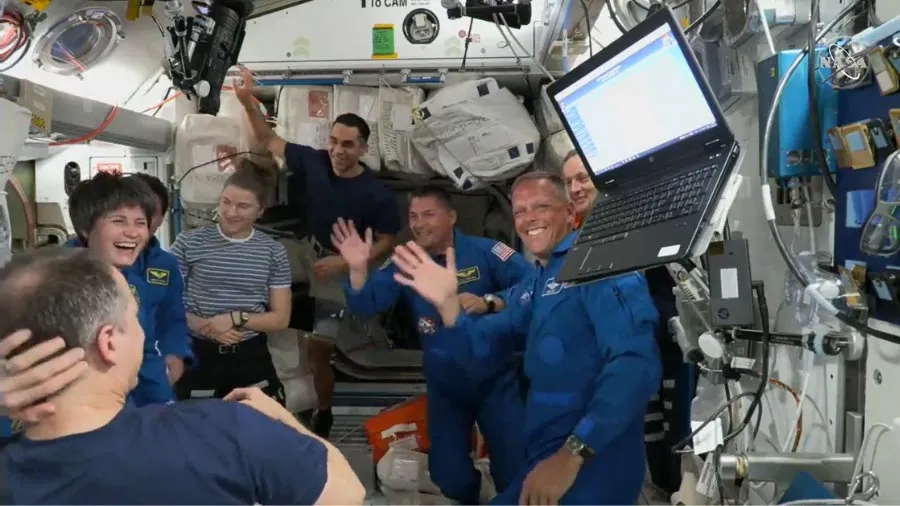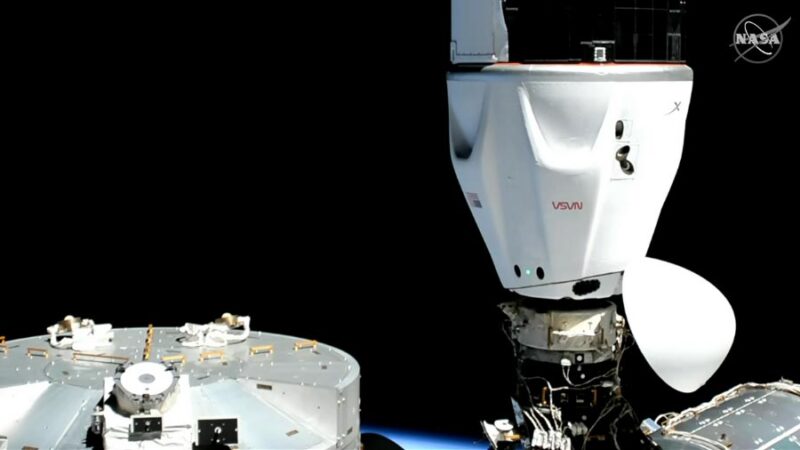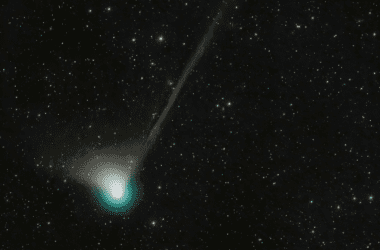
Les astronautes Crew-4 de la NASA, le commandant de mission Kjell Lindgren, le pilote Bob Hines et la spécialiste de mission Jessica Watkins, ainsi que la spécialiste de mission Samantha Cristoforetti de l’ESA (Agence spatiale européenne) ont été accueillis par Crew-3 à leur arrivée à la Station spatiale internationale. Crédit : NASA
;” data-gt-translate-attributes=”[{” attribute=””>NASA astronauts Mission Commander Kjell Lindgren, Pilot Bob Hines, and Mission Specialist Jessica Watkins, and Mission Specialist Samantha Cristoforetti of ESA (European Space Agency) now are aboard the International Space Station following Crew Dragon’s hatch opening about 9:15 p.m. EDT, Wednesday, April 27.
SpaceX Dragon Freedom docked to the complex at 7:37 p.m. EDT while the spacecraft were flying about 261 miles above the Pacific Ocean. Following Crew Dragon’s link up to the Harmony module, the astronauts aboard Dragon and the space station conducted standard leak checks and pressurization between the spacecraft in preparation for the hatch opening.

The SpaceX Dragon Freedom capsule is seen after docking to the International Space Station while the station was orbiting 261 statute miles above the Pacific Ocean. Credit: NASA
Crew-4 joins Expedition 67 crew of Raja Chari, Thomas Marshburn, and Kayla Barron, all of NASA, Matthias Maurer of ESA, and cosmonauts Oleg Artemyev, Sergey Korsakov, and Denis Matveev of Roscosmos.
Crew-4 astronauts launched to International Space Station at 3:52 a.m. Wednesday, April 27, from Launch Complex 39A at NASA’s Kennedy Space Center in Florida. The international crew of astronauts will serve as the fourth commercial crew rotation mission aboard the space station, spending several months on the orbital complex on a science expedition mission.

A SpaceX Falcon 9 rocket carrying the company’s Crew Dragon spacecraft is launched on NASA’s SpaceX Crew-4 mission to the International Space Station with NASA astronauts Kjell Lindgren, Robert Hines, Jessica Watkins, and ESA (European Space Agency) astronaut Samantha Cristoforetti onboard, Wednesday, April 27, 2022, at NASA’s Kennedy Space Center in Florida. Credit: NASA/Joel Kowsky
A SpaceX Falcon 9 rocket propelled the Dragon spacecraft into orbit carrying Mission Commander Kjell Lindgren, Pilot Bob Hines, and Mission Specialist Jessica Watkins, all NASA astronauts, and Mission Specialist Samantha Cristoforetti of ESA (European Space Agency). The crew will conduct a science expedition in microgravity aboard the space station.
“Liftoff! The past few days at Kennedy Space Center have been inspiring and busy with the return of the Axiom crew and now the successful launch of Crew-4 astronauts to the International Space Station,” said NASA Administrator Bill Nelson. “Aboard station, Kjell, Bob, Jessica, and Samantha will carry out research investigations that will help NASA prepare for longer duration stays on the Moon – and eventually Mars. These missions wouldn’t be possible without the dedicated NASA and SpaceX teams here on Earth. Godspeed, Crew-4!”

The SpaceX Falcon 9 rocket, with the company’s Crew Dragon atop, soars upward after a 3:52 a.m. EDT liftoff from Launch Complex 39A at Kennedy Space Center in Florida for NASA’s SpaceX Crew-4 mission on April 27, 2022. Aboard the Dragon are NASA astronauts Kjell Lindgren, Bob Hines, and Jessica Watkins, and ESA (European Space Agency) astronaut Samantha Cristoforetti. Credit: NASA/Kim Shiflett
This Crew-4 mission is the first launch for Hines and Watkins, and the second flight to the station for Lindgren and Cristoforetti. It launched in a new Dragon spacecraft, named Freedom by the crew, and a Falcon 9 booster flying its fourth mission into space. This is the fifth SpaceX flight with NASA astronauts – including the Demo-2 test flight in 2020 to the space station – as part of the NASA’s Commercial Crew Program.

The SpaceX Falcon 9 rocket, with the company’s Crew Dragon atop, soars upward after a 3:52 a.m. EDT liftoff from Launch Complex 39A at Kennedy Space Center in Florida for NASA’s SpaceX Crew-4 mission on April 27, 2022. Credit: NASA/Kim Shiflett
During Dragon’s flight, SpaceX monitored a series of automatic spacecraft maneuvers from its mission control center in Hawthorne, California, and NASA teams monitored space station operations throughout the flight from the Mission Control Center at the agency’s Johnson Space Center in Houston.
Dragon docked autonomously to the space-facing port of the station’s Harmony module at 7:37 p.m. on Wednesday, April 27.
“NASA, SpaceX and our international partners have worked tirelessly to ensure that the International Space Station continues conducting important research in microgravity, and working on a whole host of activities that benefit humanity and opens up access to more people in space,” said Kathryn Lueders, associate administrator for NASA’s Space Operations Mission Directorate in Washington. “Crew-4’s launch, less than two days after the return of the first all-private mission to station, exemplifies the spirit and success of the Commercial Crew Program to help maximize use of low-Earth orbit for years to come, testing the technologies we need for the Artemis program and beyond.”
Lindgren, Hines, Watkins, and Cristoforetti will join the space station’s Expedition 67 crew of Raja Chari, Thomas Marshburn, and Kayla Barron, all NASA astronauts, Matthias Maurer of ESA, and cosmonauts Oleg Artemyev, Sergey Korsakov, and Denis Matveev of Roscosmos. For a short time, the number of crew aboard the space station will increase to 11 people until Crew-3 astronauts Chari, Marshburn, Barron, and Maurer return to Earth a few days later.
Crew-4 is the third commercial crew mission to fly an ESA astronaut.
Le prochain vol vers la Station spatiale internationale a été lancé ! La mission SpaceX Crew-4 de la NASA a permis à quatre nouveaux membres d’équipage de rejoindre la station spatiale et d’alimenter la prochaine étape de la recherche scientifique révolutionnaire. Rejoignez Kjell Lindgren, Bob Hines et Jessica Watkins de la NASA, ainsi que l’astronaute de l’ESA (Agence spatiale européenne) Samantha Cristoforetti avant le lancement, pour un aperçu de leur expédition en orbite terrestre basse, et partagez leur excitation à l’idée de voler pour la première fois à bord du véhicule Dragon. Crédit : NASA
“Je suis très heureux de voir le lancement réussi de Samantha Cristoforetti et de ses collègues de l’équipage 4. Samantha prendra la relève de Matthias Maurer et continuera à représenter l’Europe et à soutenir les expériences européennes à bord de la station spatiale tout au long de sa mission”, déclare Josef Aschbacher, directeur général de l’ESA.
David Parker, directeur de l’exploration humaine et robotique de l’ESA, ajoute : “Samantha a été un excellent modèle – d’autant plus qu’à bord de la station spatiale, elle assumera le rôle de chef de l’USOS, responsable des opérations au sein du segment orbital américain de la Station spatiale internationale, composé de modules et de composants américains, européens, japonais et canadiens.”
Les astronautes de l’équipage 4 passeront plusieurs mois à bord de la station spatiale pour effectuer de nouvelles missions. recherche scientifique dans des domaines tels que la science des matériaux, les technologies de la santé et la phytologie, afin de préparer l’exploration humaine au-delà de l’orbite terrestre basse et de favoriser la vie sur Terre.

L’astronaute de la NASA et commandant de l’équipage Crew-4 de SpaceX, Kjell Lindgren, représentant le programme d’équipage commercial de la NASA, est photographié lors d’une session de formation à l’intérieur d’une maquette du véhicule Crew Dragon au siège de SpaceX à Hawthorne, en Californie. Crédit : SpaceX
La mission Crew-4 poursuit les efforts de la NASA pour maintenir le leadership américain en matière de vols spatiaux habités. Les missions régulières et de longue durée de rotation des équipages commerciaux permettent à la NASA de poursuivre les importantes recherches et investigations technologiques qui ont lieu à bord de la station. Ces recherches profitent aux habitants de la Terre et jettent les bases de l’exploration future de la Lune et de Mars, en commençant par les missions Artemis de l’agence, qui prévoit de faire atterrir la première femme et la première personne de couleur sur la surface lunaire.
Lindgren est le commandant du vaisseau spatial Dragon et de la mission Crew-4. Il est responsable de toutes les phases du vol, du lancement à la rentrée dans l’atmosphère, et sera ingénieur de vol de la mission Expedition 67. Il s’agira du deuxième vol spatial de Lindgren depuis qu’il est devenu astronaute en 2009. En 2015, il a passé 141 jours à bord du laboratoire orbital en tant qu’ingénieur de vol pour les expéditions 44 et 45. Titulaire d’un diplôme de médecine d’urgence, il a travaillé auparavant à la NASA Johnson en tant que médecin de vol pour l’entraînement et les opérations de la station spatiale et a été chirurgien adjoint de l’équipage des navettes spatiales STS-130 et Expedition 24. Lindgren est né à Taipei, à Taiwan, et a passé la majeure partie de son enfance en Angleterre avant d’être diplômé de l’Académie de l’armée de l’air américaine.
Hines est le pilote du vaisseau spatial Dragon et le commandant en second de la mission. Il est responsable des systèmes et des performances du vaisseau spatial. À bord de la station, il sera ingénieur de vol de la mission Expedition 67. Il s’agira de son premier vol depuis sa sélection en tant qu’astronaute en 2017. Hines a servi plus de 22 ans dans l’armée de l’air américaine en tant que pilote d’essai, pilote de chasse et pilote instructeur. Avant sa sélection en 2017, il était pilote de recherche chez Johnson.
Watkins est un spécialiste de mission pour Crew-4 et travaillera en étroite collaboration avec le commandant et le pilote pour surveiller l’engin spatial pendant le lancement dynamique et le lancement de la mission.phases de rentrée dans l’atmosphère. Une fois à bord de la station, elle occupera le poste d’ingénieur de vol pour l’Expédition 67. Mme Watkins a grandi à Lafayette, dans le Colorado, et a étudié la géologie à l’université Stanford, à Palo Alto, en Californie, et à l’université de Californie, à Los Angeles. En tant que géologue, elle a étudié la surface de Mars et a été collaboratrice de l’équipe scientifique du Jet Propulsion Laboratory de la NASA à Pasadena, en Californie, travaillant sur le rover Curiosity du Mars Science Laboratory. Elle a également été sélectionnée comme astronaute de la NASA en 2017, et ce sera son premier voyage dans l’espace.
Cristoforetti servira également en tant que spécialiste de mission, travaillant à la surveillance du vaisseau spatial Dragon pendant les phases dynamiques de lancement et de rentrée en vol. Elle sera ingénieur de vol pour la mission Expedition 67. Il s’agira de son deuxième voyage dans l’espace après avoir passé cinq mois en 2015 en tant qu’ingénieur de vol pour les expéditions 42 et 43. Née à Milan, en Italie, elle a été pilote de chasse dans l’armée de l’air italienne avant d’être sélectionnée comme astronaute de l’ESA en 2009. En 2019, elle a servi en tant que commandant de la 23e mission d’opérations en environnement extrême de la NASA lors d’un séjour de 10 jours à Aquarius, la seule station de recherche sous-marine au monde.



